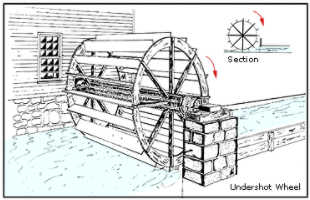Did you know that there are many types of water wheels and ways in which the mill can convert natural power (falling water) into mechanical energy?
Mills have used different types of processes over time to convert flowing water into mechanical energy. The undershot wheel was the earliest and simplest, but least efficient form. The undershot  wheel sat directly in the current of the water, and the water passing underneath the wheel turned it in a clockwise rotation. In this type, the wheel (and power it generated) were entirely at the mercy of the flowing water.
wheel sat directly in the current of the water, and the water passing underneath the wheel turned it in a clockwise rotation. In this type, the wheel (and power it generated) were entirely at the mercy of the flowing water.
Slightly more efficient was the breastshot wheel. The breastshot wheel utilized both kinetic energy (movement of the wheel) and potential energy (height of the water drop and weight of the falling water). The breastshot wheel required a small dam and flu to direct the fall of water, striking the wheel around its mid-point, and the wheel rotated in a clockwise fashion.
The overshot wheel was more efficient still, although it required more of an investment in infrastructure. Overshot wheels required a greater head (or height) of water, with a higher dam and  millpond, with an elevated flume, penstock or headrace to deliver water to the wheel, releasing the water over the wheel past its mid-point axel. The power generated was entirely through the drop of water and gravity, rotating the wheel counter-clockwise. The development of the flume and headrace system associated with overshot wheels represented a leap in technology, and transferred more control to the miller.
millpond, with an elevated flume, penstock or headrace to deliver water to the wheel, releasing the water over the wheel past its mid-point axel. The power generated was entirely through the drop of water and gravity, rotating the wheel counter-clockwise. The development of the flume and headrace system associated with overshot wheels represented a leap in technology, and transferred more control to the miller.
Other common types of water wheels in mills included the Poncelet wheel and, as technological knowhow evolved, the turbine. All were developed with the desire to create more efficient and powerful ways of converting natural water power into mechanical energy.
Learn more about the Mills of Mississauga in our feature video “Flow and Fall: The Lost Mills of Mississauga” in which Historian Matthew Wilkinson reflects on the history and fate of the milling industries that were the building blocks of Mississauga’s early hamlets and villages, but are missing from our landscape today.



Comments are closed.